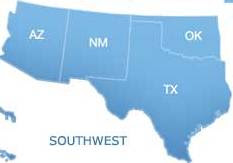According to data from the Health Resources and Services Administration (HRSA), as of March 31, 2025, over 59.7 million Americans resided in a dental health professional shortage area (HPSA). A dental health HPSA is a geographic area, population group, or facility where community residents are underserved for dental care because too few dentists work in the area relative to the size of the population. In the four-state Southwestern U.S., as of March 31, 2025, over 6.0 million residents lived in dental care shortfall areas. The HRSA estimates that HPSAs in the Southwest would need 1,099 more dentists to eliminate the dental care shortfall in the region. From 3/31/25 HRSA data, here is a summary look at the dental care shortfall in the Southwestern U.S.:

|
The Dental Care Shortfall in the Southwestern U.S. |
|
| State |
(1) HPSAs |
(2) Population |
(3) Shortfall |
| AZ |
207 |
2,046,279 |
339 |
| NM |
106 |
865,757 |
171 |
| OK |
187 |
1,083,631 |
211 |
| TX |
264 |
2,050,751 |
378 |
|
|
|
|
| Region |
764 |
6,046,418 |
1,099 |
|
|
|
|
| U.S. |
7,054 |
59,718,174 |
10,143 |
|
|
|
|
(1) HRSA-designated Geographic Units, Population Groups, and Facilities with a dental care shortfall
(2) Population of designated HPSAs
(3) Dental Care practitioners needed to remove HPSA Designation
Source: Designated HPSA Quarterly Summary, 3/31/25 (HRSA)

